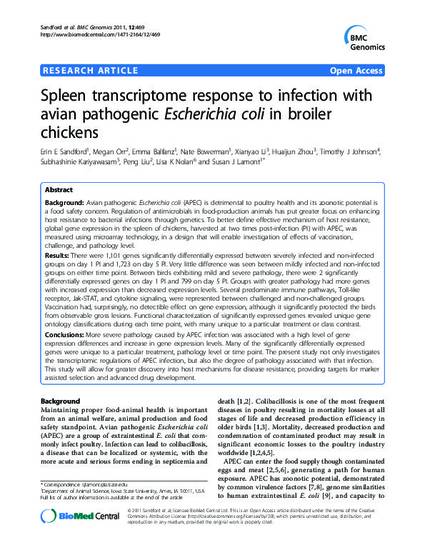
Article
Spleen transcriptome response to infection with avian pathogenic Escherichia coli in broiler chickens
BMC Genomics
Document Type
Article
Disciplines
Publication Date
9-27-2011
DOI
10.1186/1471-2164-12-469
Abstract
Background: Avian pathogenic Escherichia coli (APEC) is detrimental to poultry health and its zoonotic potential is a food safety concern. Regulation of antimicrobials in food-production animals has put greater focus on enhancing host resistance to bacterial infections through genetics. To better define effective mechanism of host resistance, global gene expression in the spleen of chickens, harvested at two times post-infection (PI) with APEC, was measured using microarray technology, in a design that will enable investigation of effects of vaccination, challenge, and pathology level.
Results: There were 1,101 genes significantly differentially expressed between severely infected and non-infected groups on day 1 PI and 1,723 on day 5 PI. Very little difference was seen between mildly infected and non-infected groups on either time point. Between birds exhibiting mild and severe pathology, there were 2 significantly differentially expressed genes on day 1 PI and 799 on day 5 PI. Groups with greater pathology had more genes with increased expression than decreased expression levels. Several predominate immune pathways, Toll-like receptor, Jak-STAT, and cytokine signaling, were represented between challenged and non-challenged groups. Vaccination had, surprisingly, no detectible effect on gene expression, although it significantly protected the birds from observable gross lesions. Functional characterization of significantly expressed genes revealed unique gene ontology classifications during each time point, with many unique to a particular treatment or class contrast.
Conclusions: More severe pathology caused by APEC infection was associated with a high level of gene expression differences and increase in gene expression levels. Many of the significantly differentially expressed genes were unique to a particular treatment, pathology level or time point. The present study not only investigates the transcriptomic regulations of APEC infection, but also the degree of pathology associated with that infection. This study will allow for greater discovery into host mechanisms for disease resistance, providing targets for marker assisted selection and advanced drug development.
Rights
This is an Open Access article distributed under the terms of the Creative Commons Attribution License (http://creativecommons.org/licenses/by/2.0), which permits unrestricted use, distribution, and reproduction in any medium, provided the original work is properly cited.
Copyright Owner
Sandford et al
Copyright Date
2011
Language
en
File Format
application/pdf
Citation Information
Erin E. Sandford, Megan Orr, Emma Balfanz, Nathaniel C. Bowerman, et al.. "Spleen transcriptome response to infection with avian pathogenic Escherichia coli in broiler chickens" BMC Genomics Vol. 12 (2011) p. 469 Available at: http://works.bepress.com/lisa_nolan/34/

This article is from BMC Genomics 12 (2011): 469, doi:10.1186/1471-2164-12-469.